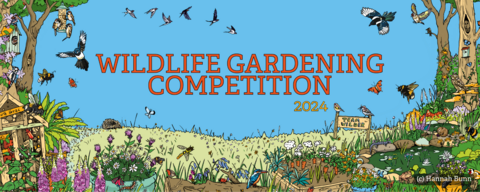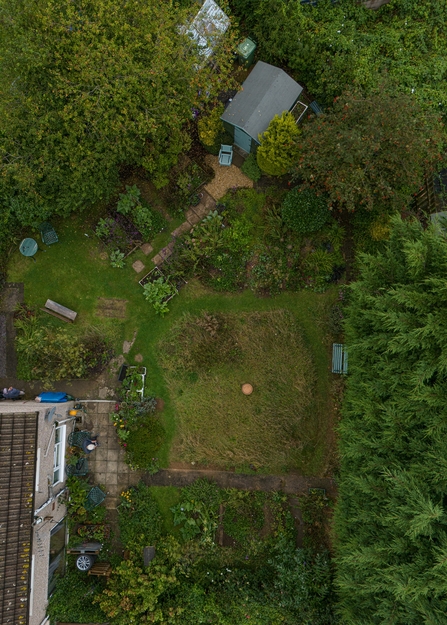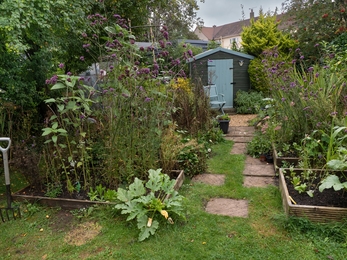
Hannah Bunn
Individual garden: Helen Alloush
Name: Helen Alloush
Category: Individual garden
Area: Yate
Tell us what you or your group love about your garden
Helen: One of the things I love most about the garden is the journey through each year as we experience the changing seasons, anticipating and enjoying the succession of plants and flowers and the cycle of wildlife that they support. I love that each season has its own little wonders and wildlife events, whether it's a month buzzing with insects and birdsong and brimming with flowers, or a fruitful autumn with wildlife stocking up and finding shelter in preparation for colder months ahead.
I love watching spring unfold in the garden, from first shoots erupting and blossoms appearing, growth accelerating, and the wave of blue forget-me-nots that inevitably spreads over the garden every April, with bulbs popping up everywhere - tulips, alliums' while queen bumblebees are on the wing, mining bees busy, and so many other insects enjoying the feast of flowers! It's a joy to catch first sight of a hedgehog or slowworm emerging from hibernation. Meanwhile a general crescendo of birdsong fills the air as the breeding season is getting under way, and there's nothing I love more than being able to just step out of the house and be in the midst of our own little piece of nature.
Each flower or insect has its moment in the spotlight and sadly will fade away, but then there's still the palate of blazing summer colours to look forward to, bringing more butterflies, bees and other insects which are yet to emerge. I love the excitement on first spotting fledglings out of their nests, the parent birds busy non-stop feeding their young. Whether simply relaxing for a few minutes, absorbing the surroundings and observing wildlife, or engaging in gardening tasks, the garden is also of great benefit to health and we always feel better and less stressed after spending a little time there. It's definitely my happy place.
What makes your garden wildlife friendly?
Helen: By considering basic needs such as shelter, food and access to water, I have tried to make my garden a welcoming place for local wildlife to visit. For example there's a hedgehog hole cut in the gate to allow them to enter, and where possible, I have ensured access via hedges or fences to adjoining gardens. The entire perimeter of the garden now consists of hedging - a mixture of several species, native and other, deciduous and evergreen, flowering at different times of year, fruit and berry bearing, and includes some mature trees of different sizes.
Such variety means there is always shelter available for birds, moths, etc; there is always some shrub or tree in flower for nectaring insects. I plant honeysuckle along the hedges to climb among them, providing even more flowers and berries.
Ivy is abundant in the garden and so valuable to wildlife, firstly creating dense ground cover, then climbing the tree trunks to offer ideal nesting possibilities for birds such as robins and wrens. Finally, much higher up among the foliage, the ivy produces its flowers, which late in the year will be buzzing with wasps and other insects, while also important to the holly blue butterfly's life cycle. Water is always available to wildlife, with a few water bowls at different levels, suitable for insects, birds and small animals. There's also a small pond with sloping beach and plants growing in and around the water.
Bird feeders are hung from the trees and there's a bird table, used mainly during the winter months to supplement natural foods when these are scarcer. To maximise what is naturally available, I leave flower seed heads uncut until spring. I have made and installed nesting boxes for tits, a shelter for hedgehogs an insect hotel and bee bricks. Other features include dead hedges and wild areas where nettles, brambles and other wild plants of value to wildlife are left to grow.
Some areas of lawn are are kept short, where ground-feeding birds such as blackbirds can run around. Another area of lawn was converted to a mini meadow a few years ago, which is still developing and is mowed only once or twice a year. The long grasses and flowers provide an environment attractive to many invertebrates and other species.
No pesticides or chemical weedkillers are used in the garden. Any wild plants that arrive are generally welcomed, unless in an inconvenient place. Two of my favourites, thistle and figwort can achieve quite a large stature and make aesthetically pleasing feature plants, as well as supporting numerous species.
In my choice of flowering plants, I aim for a succession of blooms throughout the year, with different flower shapes to suit the needs of pollinators. With climate change in mind, I am trying to include more drought resistant plants. I also grow an assortment of food plants such as beans, courgettes, root vegetables and brassicas.
The cutting back of plants is left until after winter, and leaf litter left or swept under hedges, ensuring ample winter shelter for invertebrates and allowing pupating insects to remain undisturbed.
Vote for Helen!

John Seager







